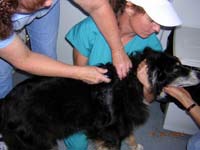A publication of student work created in the Journalism Program at CSU,
Sacramento
•
Rules for using CCN content
––
You may use any story from the Capital Campus News if you retain the
byline and CCN credit.
––
As a courtesy, please send us an e-mail to let us know you are using
it.
•
Contact a CCN editor
Communication
Studies
|
Sacramento
shelters hope to ease lost pet problem
with mandatory microchips
By
Chason Wainwright
Capital Campus
News
October
31, 2004
Shortly after Veternarian Laura Warner moved to Sacramento from Oklahoma
in 1999, her two Shetland Sheepdogs, Macy and Qbec, escaped from her sister’s
house
.
But because Warner, a veterinarian at the City of Sacramento Animal Care
and Services shelter, had inserted microchip identifications in both her
dogs, she was reunited with her dogs later that day.
Three of Sacramento-area animal shelters - Sacramento County Animal Care
and Regulation, Sacramento SPCA and City of Sacramento Animal Care Services
–– now require all adopted animals to have microchips implanted
in hopes of making it easier to bring lost pets and their owners back
together.
As part of an agreement made earlier this year between the animal shelters
and Washington-based Pet-Ark, the shelters can buy AVID (American Veterinary
Identification Devices) microchips at a reduced price. In return the shelters
have agreed to implant the identification chips in all adopted animals
.
“Microchipping is the greatest invention for dogs and cats since
dog and cat food,” said Rick Johnson, executive director of the
Sacramento SPCA
.
Sally Pometta, adoption center manager for the Sacramento SPCA, said they
used to offer microchipping at a discounted rate of $15 to new adopters.
About half the people took advantage of the reduced price.
“But the rest would say ‘I’ll get it done later’
or ‘I’ll have it done when I go see my vet’ and half
the time they would forget,” Pometta said. The shelters now charge
for microchipping as part of the regular adoption fees.
 According
to Dr. Alana McQuarry, a veterinarian at the Country Vet Clinic in Live
Oak, the AVID microchips are about the size of a grain of rice and come
packaged individually inside a hypodermic needle. To inject the microchip,
a veterinarian pulls up the skin between the shoulder blades, inserts
the needle, injects the chip and then scans the chip to read the unique
number. According
to Dr. Alana McQuarry, a veterinarian at the Country Vet Clinic in Live
Oak, the AVID microchips are about the size of a grain of rice and come
packaged individually inside a hypodermic needle. To inject the microchip,
a veterinarian pulls up the skin between the shoulder blades, inserts
the needle, injects the chip and then scans the chip to read the unique
number.
“The whole procedure takes less than a minute,” McQuarry said.
The animal does not need to be under anesthesia, but if an animal is undergoing
another procedure, such as spaying or neutering, injecting a microchip
while the animal is under anesthesia is convenient, McQuarry said.
Once an adopted animal has been microchipped, the unique AVID microchip
number is registered with AVID by the animal’s new owner. AVID maintains
a database of animal information called PETtrac that allows pet owners
to enter information about themselves and their animals. PETtrac allows
an owner to enter information for up to two different contacts and additional
information if an animal has special medical conditions that need attention.
Pet owners can access the database to make changes if they move or if
the animal’s medical condition changes.
If an animal becomes lost and ends up at a shelter or a vet clinic, most
shelters and clinics know to scan for a microchip. The clinic can call
a toll free number to get the owner contact information.
Diane Fabretti, senior animal control officer for Sacramento County Animal
Care and Regulation, said she does a microchip scan on every animal she
brings back to the shelter.
Fabretti said that two purebred Bichon Frise dogs were adopted from the
county shelter while the owner was on vacation because the dogs didn’t
have tags or other forms of identification. If they had, the shelter would
have been required to hold them for 10 days before putting them up for
adoption, instead of four days.
“These were highly desirable dogs and they were adopted as soon
as they became available,” Fabretti said. “By the time she
found out her dogs were missing, they had already been adopted out.”
Hector Cazeras, manager of Animal Care Services for the City of Sacramento,
hopes that mandatory microchipping and public education can help animal
owners to avoid such incidents. The City of San Diego shelter, where Cazeras
worked before Sacramento, has had a policy of mandatory microchipping
of all animals for nearly 13 years.
“Now almost every animal they pick up is microchipped,” Cazeras
said. “It is a result of microchipping all animals that are adopted
out for years and years.”
Dr. Jennifer Larsen, a veterinarian at Cordova Vet Hospital in Rancho
Cordova, said that microchip identification has advantages over other
forms of identification.
“Collars come off and tattoos can fade or smear,” Larsen said.
“Also, there is no universal location for placement of identification
tattoos.”
Service dogs often have identification tattoos in their ears while other
dogs have tattoos on the inside of their back legs, Larsen said
.
Another advantage to microchips, Larsen said, is that they continue to
work after an animal has died.
“If an animal loses its tags and is hit by a car, the chip would
allow for identification of the dead animal and notification of its owners,”
Larsen said.
Fabretti compared identifying a lost animal with a microchip to identifying
an abandoned car on the side of the highway.
“The highway patrol will look up the cars vehicle identification
number (VIN) and with that number they can figure out who owns it,”
Fabretti said.
BACK
TO STORY INDEX
|